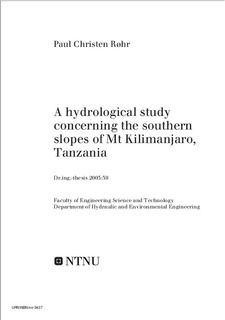| dc.contributor.author | Røhr, Paul Christen | nb_NO |
| dc.date.accessioned | 2014-12-19T11:24:40Z | |
| dc.date.available | 2014-12-19T11:24:40Z | |
| dc.date.created | 2003-10-30 | nb_NO |
| dc.date.issued | 2003 | nb_NO |
| dc.identifier | 124817 | nb_NO |
| dc.identifier.isbn | 82-471-5589-3 | nb_NO |
| dc.identifier.uri | http://hdl.handle.net/11250/231188 | |
| dc.description.abstract | The hydrological conditions on the southern slopes of Mt Kilimanjaro, Tanzania, are complex and not similar to very many other places. High annual precipitation with complex distribution patterns occurs on these slopes. Extensive water consumption and concentrated groundwater sources of unknown origin are found on the plains. The distribution and utilisation of the scarce water resources can easily be influenced by change in these and in other factors. A hydrological model is developed for the area and used for studying these processes and their influence on potential change in land use and climate.
This study is a part of a cooperative project between the University of Dar es Salaam, Tanzania and the Norwegian University of Science and Technology in Trondheim, Norway, focusing on how changes in land use influence the hydrologic -al responses of a catchment.
Extensive fieldwork has been performed in the course of several stays in the area. Three gauging stations were established on the slopes south of Mt Kilimanjaro for gauging the runoff from areas with and without influence from human activities. Precipitation and temperature measurements from the lower boundary of the forest reserve and up to 4000 metres above sea level (masl) were performed. Extensive field surveys were performed for identifying and understanding the hydrological processes taking place in the catchment. In addition, hydrological data were collected from the regular observation network.
The stream gauging and the precipitation measurements were analysed. The results were used in a water balance assessment of the southern slopes of Mt Kilimanjaro for determination of the extent of infiltration in the higher areas. Based on the results from the three sub-studies, a hydrological model was developed which describes the vertical water balance above and in the soil zone. The model can be used for investigation of the hydrological impact of changes in land use or climate. The model takes meteorological data as an input in addition to parameters describing the land cover and water demand in the catchment. This was applied for analysing the impact of prospective land use and climate changes.
The analysis of the discharge data and field inspections indicated that no surface runoff comes from the area above 2800 masl. The study of the precipitation data resulted in a function describing the relative distribution of precipitation according to elevation for the southern slopes of Mt Kilimanjaro. The analysis indicates that the maximum precipitation intensity occurs about 400-500 meters higher than previously assumed. The water balance assessment gave indications on the extent of the deep groundwater infiltration on the southern slopes of Mt Kilimanjaro.
These findings were incorporated into the hydrological model, which was calibrated for three catchments on the southern slopes of Mt Kilimanjaro. The calibration for a small 21 km2 uphill catchment, a mid-hill 52 km2 catchment and a large 1783 km2 catchment reaching from the plains to the peak of Mt Kilimanjaro showed good accordance between the simulated and the observed discharge for the three catchments.
The calibrated model was successfully used for simulating the period from 1958 to 2000 for the large catchment and showed good accordance for the simulation period. Simulations with changes in forest cover, water demand and climate were performed. The climate changes simulated were based on the findings from the Intergovernmental Panel on Climate Change and land use and forest cover and were evaluated on the basis of potential management schemes. The simulations indicate that the water demand in the area is not being met, and that changes in water demand are not fully reflected in the river discharge. The results also show that the changes have greater influence in years where the water deficit is already substantial, so called “dry years”, than in years with a smaller deficit.
The tools developed and illustrated can be developed further for use in operational water management predicting the hydrological response due to changes in land use and water demand based on various management schemes. It is advised that the infrastructure developed during this work for collecting further measurements concerning the hydrological elements in the area continues to be operated. | nb_NO |
| dc.language | eng | nb_NO |
| dc.publisher | Fakultet for ingeniørvitenskap og teknologi | nb_NO |
| dc.relation.ispartofseries | Dr. ingeniøravhandling, 0809-103X; 2003:39 | nb_NO |
| dc.subject | | en_GB |
| dc.subject | Hydrogeologi | en_GB |
| dc.subject | NATURAL SCIENCES: Earth sciences: Atmosphere and hydrosphere sciences: Hydrology | en_GB |
| dc.title | A hydrological study concerning the southern slopes of Mt Kilimanjaro, Tanzania | nb_NO |
| dc.type | Doctoral thesis | nb_NO |
| dc.source.pagenumber | 202 | nb_NO |
| dc.contributor.department | Norges teknisk-naturvitenskapelige universitet, Fakultet for ingeniørvitenskap og teknologi | nb_NO |
| dc.description.degree | dr.ing. | nb_NO |
| dc.description.degree | dr.ing. | en_GB |
